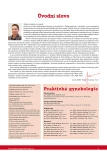Margin status of conizations with histological finding carcinoma in situ
Authors:
P. Freitag
Authors‘ workplace:
Gynekologicko‑porodnická klinika 1. LF UK a VFN v Praze
Published in:
Prakt Gyn 2010; 14(1): 10-13
Category:
Original Article
Overview
A series of 116 conizations with histological finding carcinoma in situ has been analyzed retrospectively. Positive margins were found in 37,4 % of squamous and 55,6 % of glandular carcinoma in situ cases. Endocervical versus exocervical reach has occured twice more frequently. The curretage of proximal canal of uterine cervix has allowed for non‑diagnostic material in a part of cases. Endocervical positive margin is more serious and its management has to be more active. In approximately one half of cases of reoperations because of positive margins the histological finding of reoperation was negative. Requirements for adequate performance of conization, possibilities of minimalization of positive margins occurrence and their management have been discussed.
Key words:
conization – carcinoma in situ – margin status
Sources
1. Sláma J, Freitag P, Cibula D et al. Adenoprekancerózy děložního hrdla. Čes Gynek 2006; 17(6): 446– 450.
2. Sun XG, Ma SQ, Zhang JX et al. Predictors and clinical significance of the positive cone margin in cervical intraepithelial neoplasia III patients. Chin Med J (Engl) 2009; 122(4): 367– 372.
3. Ørbo A, Arnesen T, Arnes M et al. Resection margins in conization as prognostic marker for relapse in high‑grade dysplasia of the uterine cervix in northern Norway: a retrospective long‑term follow‑up material.Gynecol Oncol 2004; 93(2): 479– 483.
4. Ostör AG, Duncan A, Quinn M et al. Adenocarcinoma in situ of the uterine cervix: an experience with 100 cases. Gynecol Oncol 2000; 79(2): 207– 210.
5. Lu HX, Chen YX, Ni J et al. Study on high risk factors associated with positive margin of cervix conization in patient with cervical intraepithelial neoplasia. Zhonghua Fu Chan Ke Za Zhi 2009; 44(3): 200– 203.
6. Murta EF, Resende AV, Souza MA et al. Importance of surgical margins in conization for cervical intraepithelial neoplasia grade III. Arch Gynecol Obstet 1999; 263(1– 2): 42– 44.
7. Rivoire WA, Monego HI, Dos Reis R et al. Comparison of loop electrosurgical conization with one or two passes in high‑grade cervical intraepithelial neoplasias. Gynecol Obstet Invest 2009; 67(4): 228– 235.
8. Shin JW, Rho HS, Park CY. Factors influencing the choice between cold knife conization and loop electrosurgical excisional procedure for the treatment of cervical intraepithelial neoplasia. J Obstet Gynaecol Res 2009; 35(1): 126– 130.
9. Miroshnichenko GG, Parva M, Holtz DO et al. Interpretability of excisional biopsies of the cervix: cone biopsy and loop excision. J Low Genit Tract Dis 2009; 13(1): 10– 12.
10. Wang T, Kong WM, Li BZ et al. Clinical management of patients with positive excision margin after cervical conization: analysis of 148 cases. Zhonghua Yi Xue Za Zhi 2008; 88(19): 1331– 1334.
11. Tillmanns TD, Falkner CA, Engle DB et al. Preoperative predictors of positive margins after loop electrosurgical excisional procedure‑Cone. Gynecol Oncol 2006; 100(2): 379– 384.
12. Bretelle F, Cravello L, Yang L et al. Conization with positive margins: what strategy should be adopted? Ann Chir 2000; 125(5): 444– 449.
13. Huang M, Anderson P. Positive margins after cervical conization as an indicator of residual dysplasia. Prim Care Update Ob Gyns 1998; 5(4): 160– 161.
14. Narducci F, Occelli B, Boman F et al. Positive margins after conization and risk of persistent lesion. Gynecol Oncol 2000; 76(3): 311– 314.
15. Dedecker F, Graesslin O, Bonneau S et al. Persistence and recurrence of in situ cervical adenocarcinoma after primary treatment. About 121 cases. Gynecol Obstet Fertil 2008; 36(6): 616– 622.
16. Young JL, Jazaeri AA, Lachance JA et al. Cervical adenocarcinoma in situ: the predictive value of conization margin status. Am J Obstet Gynecol 2007; 197(2): 195.
17. Lea JS, Shin CH, Sheets EE et al. Endocervical curettage at conization to predict residual cervical adenocarcinoma in situ. Gynecol Oncol 2002; 87(1): 129– 132.
18. Bretelle F, Agostini A, Rojat‑ Habib MC et al. The role of frozen section examination of conisations in the management of women with cervical intraepithelial neoplasia. BJOG 2003; 110(4): 364– 370.
Labels
Paediatric gynaecology Gynaecology and obstetrics Reproduction medicineArticle was published in
Practical Gynecology

2010 Issue 1
Most read in this issue
- Margin status of conizations with histological finding carcinoma in situ
- ICTP marker and breast cancer with bone metastases – our experience
- Intrahepatic cholestasis of pregnancy – selected perinatal outcomes.
- Therapeutic options for assisted reproduction in patients with impaired ovarian reserve
